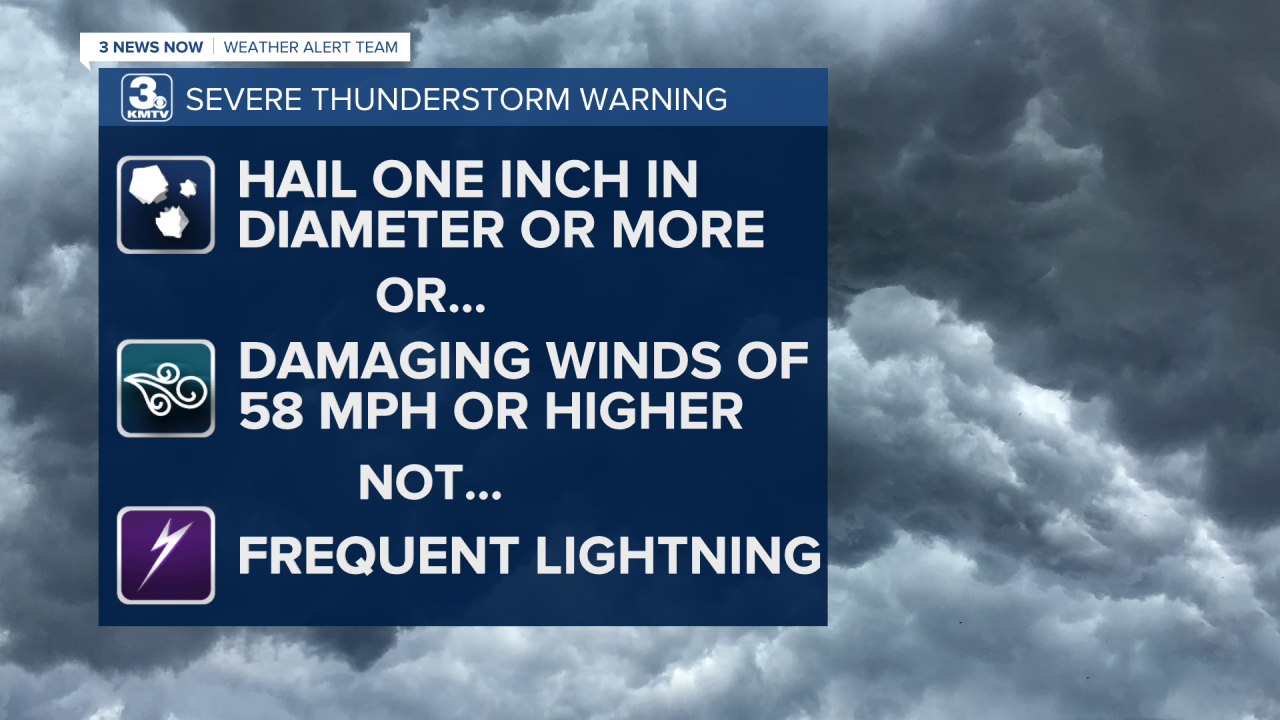March 25-29 is Severe Weather Awareness Week for Nebraska and Iowa. Each day, a different aspect of severe weather will be highlighted, explaining the science behind them, and how you can stay safe when severe weather threatens. This article will focus on the criteria needed for a thunderstorm to become severe, and more detail into hail formation.
WHAT IS A SEVERE STORM?
In a year, the United States sees on average about 100,000 thunderstorms. Of these 100,000 storms, around 10% ever reach severe criteria. In Omaha, we experience around 40-60 thunderstorms each year. So, what are the criteria for a severe thunderstorm? Although any thunderstorm can be dangerous, severe thunderstorms are classified as storms that can threaten life or property.

For a thunderstorm to be severe, it needs to meet either of the following criteria: hailstones larger than the size of a quarter (1") or wind gusts of 58 mph or greater. These numbers are because quarter-size hail or 60 mph wind is where damage can be done to property.
It is important to note that a severe thunderstorm is NOT defined by the frequency of lightning OR the amount of rain it produces.
SAFETY IN SEVERE THUNDERSTORMS
When thunderstorms threaten, there are a few things you can do to keep yourself safe. The most dangerous aspect of a thunderstorm is the lightning. When thunder roars, go indoors! If lightning were to strike your home, although rare, it could travel through electrical wiring or pipes. Therefore, avoid using any cabled electric items or get away from pipes. This includes not washing dishes or showering during thunderstorms.

For severe thunderstorms, the best way to protect yourself is to get away from windows. Hail or flying debris can break through windows and injure you. It is best to go to a lower floor into an interior space. If a tree falls, it can go through the roof, so it's best to avoid any top floors.
HOW THUNDERSTORMS/HAIL FORMS
To get a thunderstorm, there are a few simple ingredients one needs: moisture, unstable air, and a forcing mechanism (i.e. a cold front). As the sun heats the Earth's surface, the warmer air which contains plenty of water vapor begins to rise, forming an updraft. As the air rises, it cools and eventually condenses to form a cloud. Depending on how "unstable" or energized the atmosphere is, air can rise at very fast rates and reach high in the atmosphere. If a lifting mechanism such as a front is present, the air can also rise quickly. Some clouds can tower over the Earth as high as 50,000 feet!

Once clouds form, more water molecules collect on each other until it gets too heavy for the storm updraft to hold, and thus they fall as rain. This is known as a downdraft. You now have a thunderstorm.
Inside the storm's updraft, the water molecules eventually freeze into ice crystals. These ice crystals begin to combine as they rise into the thunderstorm and tumble around like clothes in a dryer as they combine with more ice. At some point, the ice will become too heavy for the thunderstorm to hold and it exits out the downdraft. These chunks of ice that fall are what we call hail.

Hail can come in many shapes and sizes. The smallest hail size is around 0.25", or a pea. Other sizes of hail commonly seen are penny (0.75"), nickel (0.88"), quarter (1"), half dollar (1.25"), ping pong ball (1.5"), golf ball (1.75"), hen egg (2"), tennis ball (2.5"), baseball (2.75"), apple (3"), softball (4"), grapefruit (4.5"), and DVD (5"). Hail can grow even larger, the largest hailstone recorded in US history occurred in Vivian, South Dakota on July 23, 2010, which measured 8" in diameter! That is a bit less than soccer ball size hail!

Fun fact: the 2nd largest hailstone recorded in US history happened right here in Nebraska! In Aurora, east of Grand Island, on June 22, 2003. The hailstone measured around 7" in diameter!




